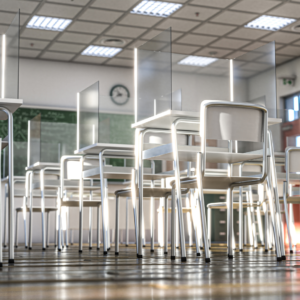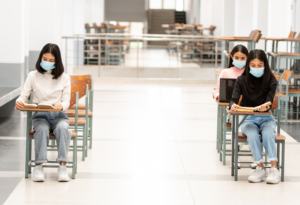The world continues to experience unprecedented closures of schools and campuses due to Covid-19. Therefore, it’s essential to ensure we create a safe environment for reopening and operating the school plant each semester. Studies show close to 50,000 new covid-19 cases have emerged on colleges and campuses in the United States alone.
Also, millions of staff and students continue to be at risk of contracting the virus as they head back to the classroom. Therefore, schools and campuses will need to adjust to limits in programming, operations, room structures, learning times, security, and socialization.
Installing PlexiGlass
 The pandemic halted everyone’s lives. It doesn’t matter whether you were a student or a teacher. You no longer could go to your respective institution to study. We found ourselves adopting safety precautions in our day to day life. These standard operating procedures soon became our means of a new normal. This is why, before the re-opening of schools, specific safety procedures are also put in place.
The pandemic halted everyone’s lives. It doesn’t matter whether you were a student or a teacher. You no longer could go to your respective institution to study. We found ourselves adopting safety precautions in our day to day life. These standard operating procedures soon became our means of a new normal. This is why, before the re-opening of schools, specific safety procedures are also put in place.
While social distancing and personal hygiene were the means of the norm, it was the installation of PlexiGlass in classrooms and offices that took center stage. These plastic panels isolate the volume around each student in a classroom. It provides them ample space to move around yet remain secluded from each other.
The set-up of these panels in high traffic areas helps limit air interactions. The virus won’t transmit itself through airborne means if you have a barrier covering you. This would be an essential piece of installation for contagion control standard operating procedures. It can significantly reduce the contagious effect of the virus.
To suggest that you install the PlexiGlass on the seats of students in a classroom is a good option indeed. Thus, without restricting freedom of movement, you can limit the possibility of future contagion.
Professors can also opt for this plastic paneling on their desks. Similarly, you can line the school administration’s office corners with these PlexiGlass panels to separate one from another. Every area of the school experiencing high traffic should have these separators.
Storing excess Items
Daily cleaning and disinfecting of surfaces are essential in the school. It would be best if you did not forget that this public place is subject to a lot of germ exchange. It is a risk you cannot take on during a pandemic. This is why school supplies are set in place. Each piece of equipment is available on-demand and goes through standard operating procedures for disinfection.
Using contaminated high-touch furniture has never been riskier until now. Reports have been coming in that the Coronavirus can live on these inanimate surfaces from a few hours to days. Its stay-time depends on the type of surface. While consistently disinfecting surfaces is the optimum solution to this problem, storing them in a clean and dry place is also essential.
Storing out excess furniture has another advantage. You can clear out corridors and pathways for social distancing. This is why you should move all of those extra desks, chairs, furniture, and rostrums to a separate room. Each piece of furniture used in school needs proper disinfection every other day.
Converting Spaces Suitable For Learning into Classrooms
 Most of our classroom spaces are not that spacious. They were not designed to ensure social distancing. On the other hand, most classrooms are closely seated spaces to encourage more interaction among students. This is something that is highly discouraged owing to the current climate. This is why other sections of the school are being converted into classrooms.
Most of our classroom spaces are not that spacious. They were not designed to ensure social distancing. On the other hand, most classrooms are closely seated spaces to encourage more interaction among students. This is something that is highly discouraged owing to the current climate. This is why other sections of the school are being converted into classrooms.
Some of the areas that are commonly selected are the auditoriums and hallways. It is always better to opt for open spaces instead of enclosed ones. There is a greater risk of contagion in a closed environment as opposed to an open one. Even then, it would help if you encouraged students to practice all SOPs. They need to equip themselves with all of the essential safety gear.
These open spaces allow the effective implementation of social distancing. Each student’s desk is placed at least six feet apart from the other one. This greatly reduces the risk of contagion.
Liquidation
Most schools are open for alternate days. Some of them are still operating through online means. This has greatly reduced the need for all that extra furniture that fills up most school buildings. Limited resources are being utilized by students and teachers alike. Donating this additional furniture seems like a suitable option. Not only will you be able to save up on the maintenance of these supplies, but they will also be able to find a fair use for them.
Hoarding up on supplies that will not be used frequently is not practical or efficient. Some furniture and equipment require maintenance and servicing. School authorities should come to a consensus regarding them. You can either choose to liquidate your assets until further notice or donate them for a good cause. This will also clear out more space. The ultimate goal is to maximize the distance between students and staff. A lower volume of traffic allows for opportunities to tackle projects such as cleaning and liquidating excess furniture and equipment.
Bottom Line
Keeping classrooms and campuses safe is everybody’s responsibility. Management, faculty, staff, and students all have a part to play to ensure they keep themselves and others safe. Practicing health and safety rules will significantly reduce the risks of exposure to personal attacks, theft, and the effects of covid-19.
